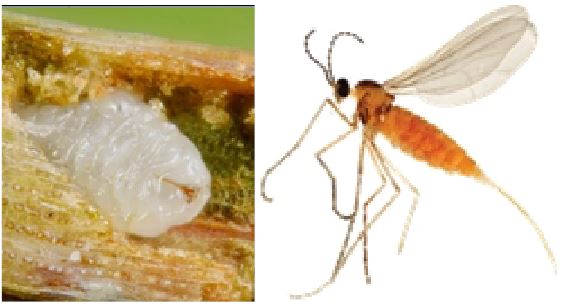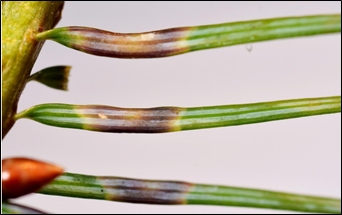PESTS AND DISEASES OF FORESTRY IN NEW ZEALAND
Gall-forming midges in Europe affecting Douglas-fir needles
Scion is the leading provider of forest-related knowledge in New Zealand
Formerly known as the Forest Research Institute, Scion has been a leader in research relating to forest health for over 50 years. The Rotorua-based Crown Research Institute continues to provide science that will protect all forests from damage caused by insect pests, pathogens and weeds. The information presented below arises from these research activities.
From Forest Health News - Issue 265 - March/April 2016.

Gall-forming midges (Diptera: Cecidomyiidae) have been reported for the first time in Europe damaging Pseudotsuga menziesii (Douglas-fir) needles. Although the species has not been identified with certainty – only larvae were found, the shape of the galls suggests it is Contarinia pseudotsugae, the most widespread and aggressive of North American species of Douglas-fir needle midges.
The findings are from Belgium and the Netherlands, and were triggered by surveys targeting needle infections by the fungal invaders Swiss needle cast (Phaeocryptopus gaeumannii) and Sirococcus shoot blight (Sirococcus conigenus).
Finds at several widely dispersed locations across the two countries were totally unexpected, and indicate that the pest is well established and has been present for several years. Since importation of Pseudotsuga plants from non-European countries has been prohibited in the EU for more than 20 years, it is unclear how the pest was introduced. Potential pathways for introduction are plants for planting, cut branches (including Christmas trees), as well as soil from countries where C. pseudotsugae occurs.

In its native area in the Eastern part of North-America, populations of C. pseudotsugae fluctuate widely. When infestations build up over several consecutive years, up to 100% of the current year needles can be affected, reducing aesthetic and market value of the host. Trees mortality has however not been reported, even in the case of severe defoliation. The future impacts of C. pseudotsugae in invaded areas are difficult to predict. In Europe, Douglas-fir is now considered an important exotic tree species, and the midge could present a risk in forests, nurseries, parks and gardens. Impacts to date appears limited though, to minor wilting symptoms on less than 10% of the needles of the current year, with occasionally higher infestation levels in the young plantations (up to ± 50%).
New Zealand now has strict plant import standards that reduce the chance of this pest and other shoot and foliage borers invading and establishing. However, there are a number of long-established exotic insect pests and native insects that damage Douglas-fir. In the next issue of Forest Health News we will discuss some of those.
Reference: EPPO 2016. Contarinia pseudotsugae (Diptera:Cecidomyiidae) Douglas-fir needle midge. https://www.eppo.int/QUARANTINE/Alert_List/insects/
Contarinia_pseudotsugae.htm
Nicolas Meurisse
This information is intended for general interest only. It is not intended to be a substitute for specific specialist advice on any matter and should not be relied on for that purpose. Scion will not be liable for any direct, indirect, incidental, special, consequential or exemplary damages, loss of profits, or any other intangible losses that result from using the information provided on this site.
(Scion is the trading name of the New Zealand Forest Research Institute Limited.)

 Farm Forestry New Zealand
Farm Forestry New Zealand

